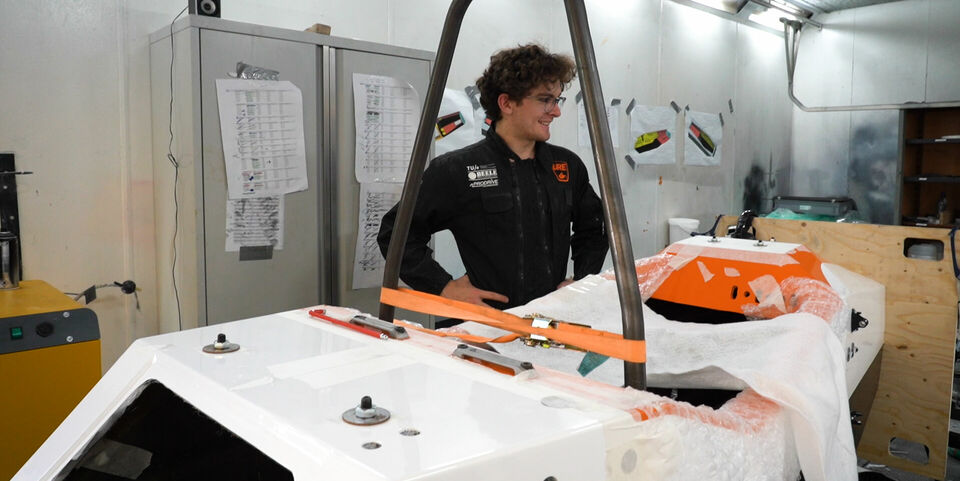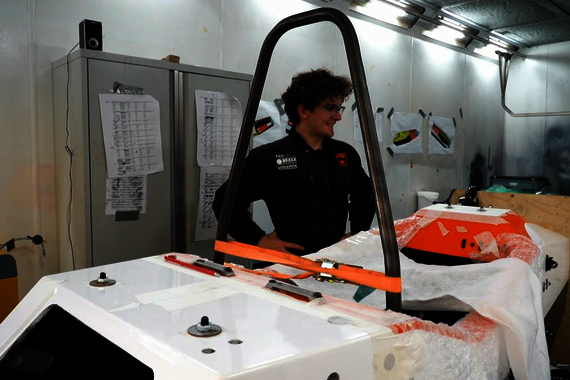URE16 will be new in almost every respect
After having used the same chassis for five years, University Racing Eindhoven decided to give its race car URE16 a fresh look this year. Narrower, longer and therefore more aerodynamic. These changes to the car’s exterior required the team to make a lot of changes inside URE16 as well. But the team goes one step further. The car’s powertrain was seriously upgraded, and URE16 will be able to change from autonomous to non-autonomous at the push of a button. The unveiling event for URE16 is scheduled on June 16th.
All this means that the team has a lot of work to do, which is why URE organized two production weekends in the month of May. Things are quiet on campus, but students on the terrain in Momentum are working hard. Some of them are at work in URE’s workshop, adding sticky carbon strips, which will later become part of URE16. Other team members, working in a different room, are busy removing a connector from one of the many cables spread out on a table in a large wire harness. Small materials of fiberglass from a firewall that’s being cut to size, are whirling around in the air inside an enclose space.
That firewall is an important component of the race car, as the team found out when URE15 caught fire during a test drive in Belgium last year. Luc Buijtels, who acts as driverless manager at URE this year, was there when it happened. “Thanks to that firewall, the driver didn’t even feel the heat, and was able to safely exit the car,” he says. Not much was left of the car after the fire. “The most serious consequence is that we can’t use URE15 to test our autonomous systems with. The only way to find out whether the software works, is by actually driving the car. It took us some extra work to get URE14 back on the road again, and we now use that car for the tests.”
Chassis
During the production weekend, it becomes perfectly clear why URE16 isn’t ready for a test drive: the chassis in the workshop is still empty. The external changes, however, have already become visible. The car’s elongated shape, the main hoop, the frame inside the car that needs to improve aerodynamics: these are just a few examples of the many ways in which URE16 differs from its predecessors.
URE16 will also have new wheels, which are slightly narrower than the wheels on previous cars. As a result, the team had to change the entire suspension. “This was the perfect moment for it. If you’re changing the chassis, you might as well change the suspension too. This allows you to optimally balance things,” Buijtels says.
The narrower tires and chassis, as well as the improved aerodynamics should significantly increase the car’s top speed. The upgraded powertrain also has something to do with that. “We go from 400 to 600 volt. This means that we have less voltage loss and more efficiency.” That upgrade did however require the team to make significant changes to the electronics. One could say that practically every component of the car is either adjusted or new. It is the team’s ambition to use URE16 as a basis for future cars.
Autonomous
URE has been focusing on autonomous driving for some time now. The team took its first steps in that direction with URE14, but converting the car form non-autonomous into autonomous proved to be an Achilles heel at the time. And that’s precisely what the team has focused on this year.
“The formula student competition of Germany came up with a new concept, where you need to be able to switch from non-autonomous to autonomous at the push of a button, without having to further convert the car. We can do that with our new car. The only thing we need to do is shove the steering actuator from and onto the steering rod with a few toothed wheels. When the car has a driver, it won’t be in the way, and when the car doesn’t have a driver, the steering actuator will take over. As far as the rest is concerned, everything you need for autonomous driving is a standard feature of the car.”
The team has to wait and see whether all the changes will work out in practice. Designing and building a race car in just one year takes some strict planning, Buijtels says. That is why he’s glad that some progress was made during the production weekends. On Thursday, June 16th, during the roll-out event in Atlas, the team will find out whether all the hard work was enough to present URE16 to the public.



Discussion